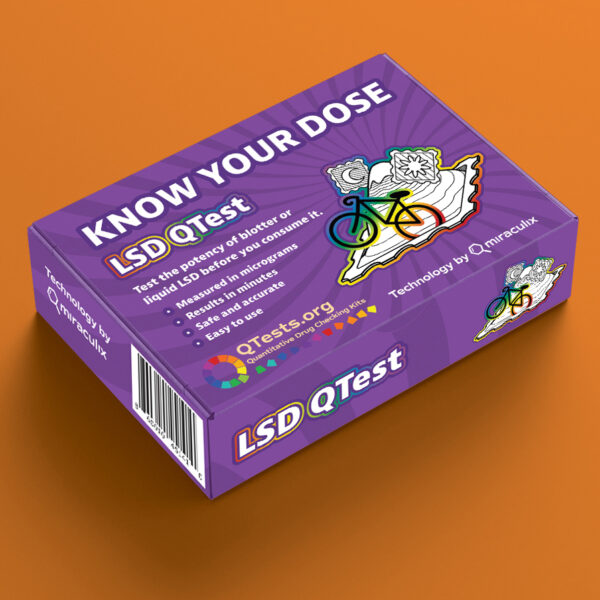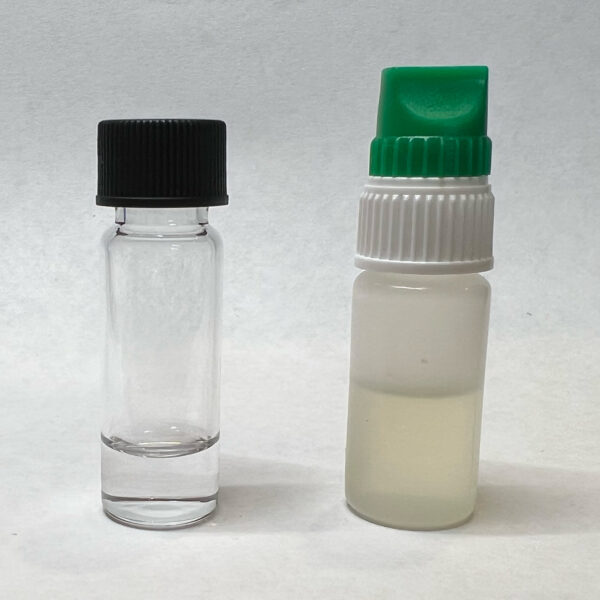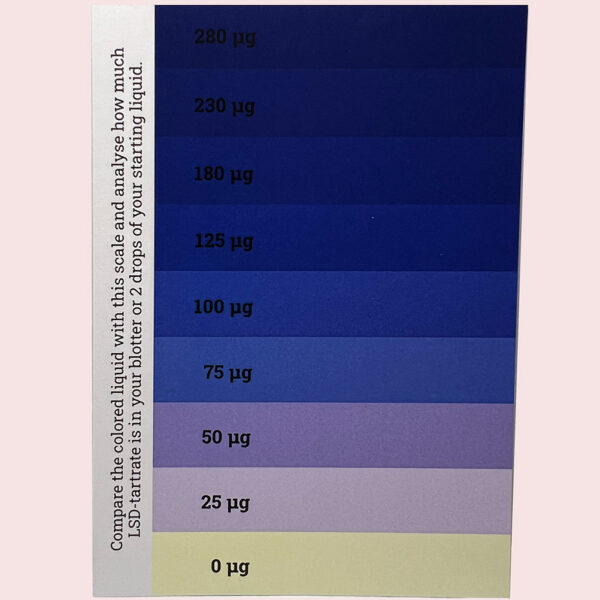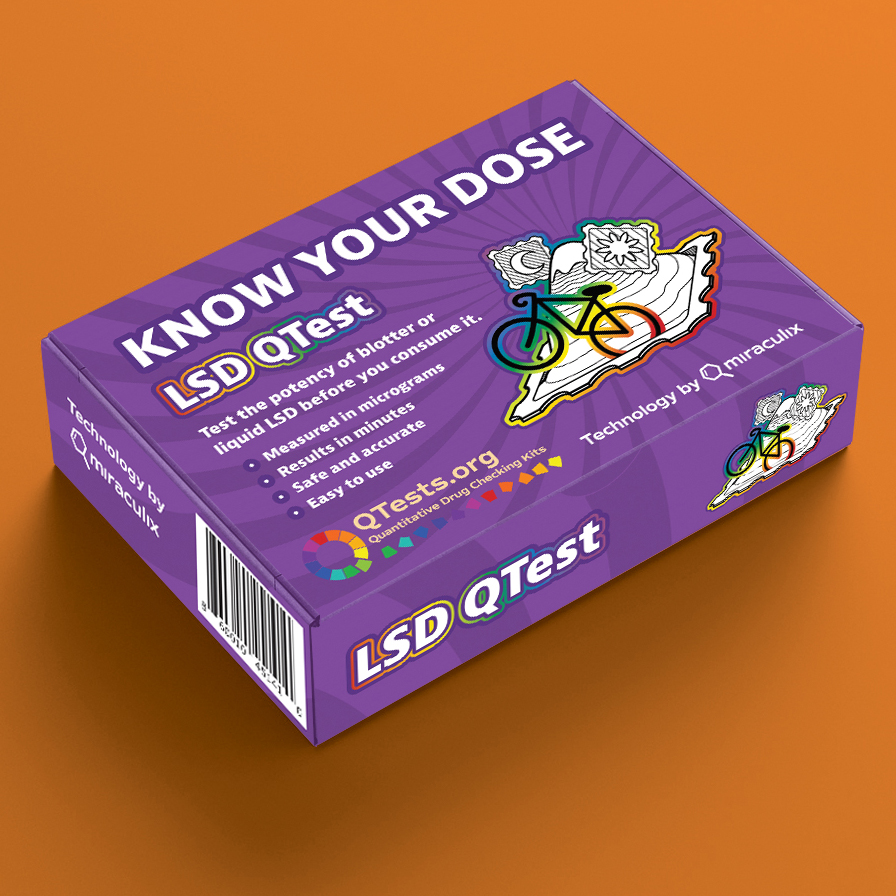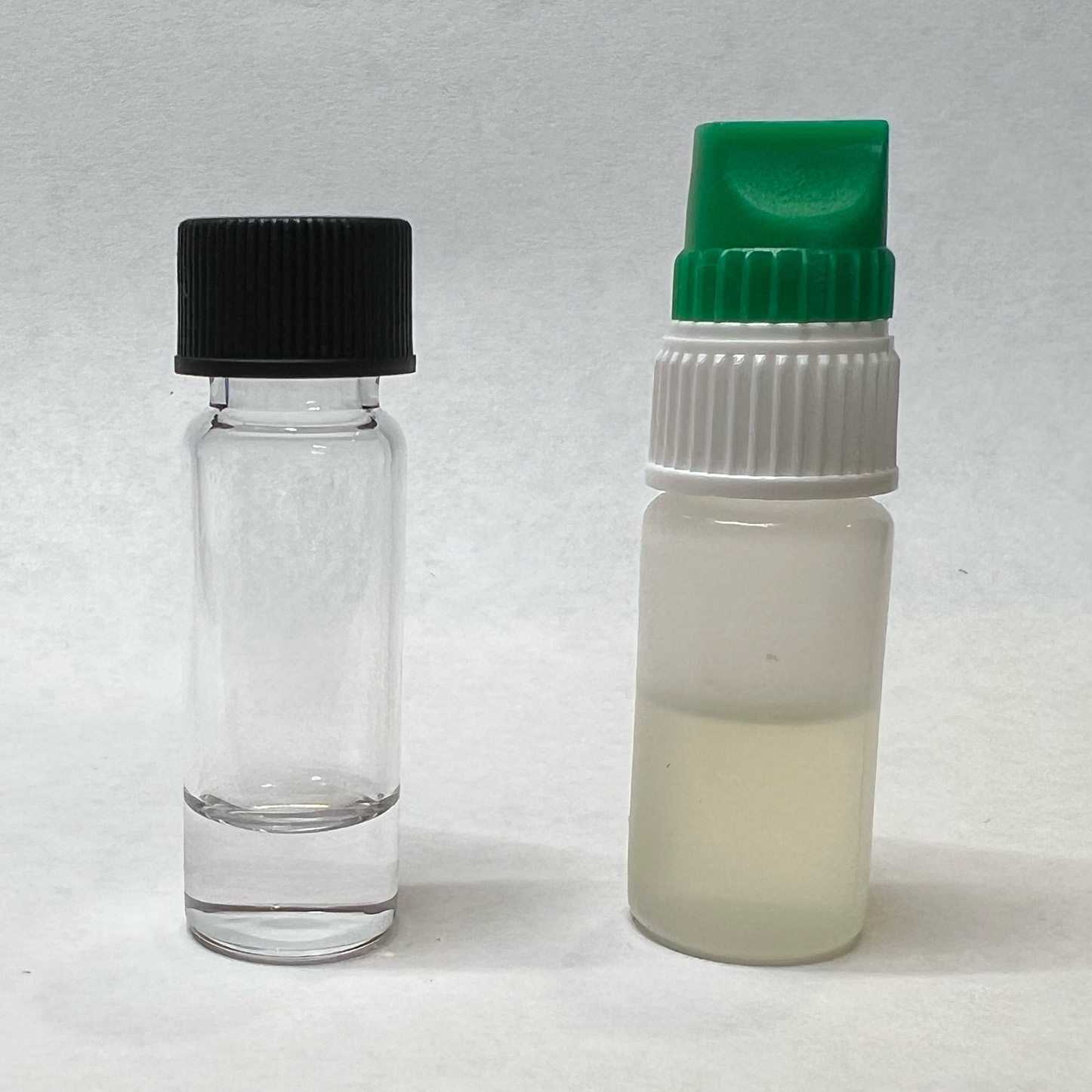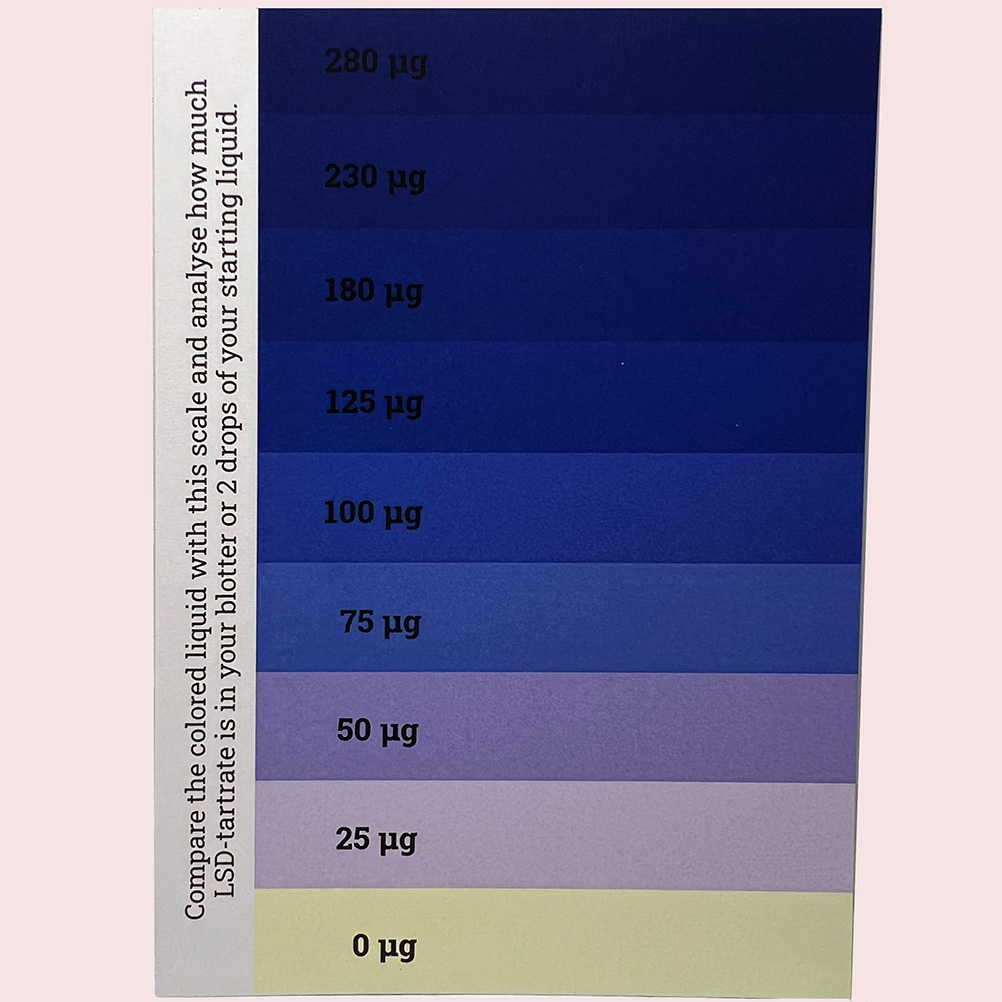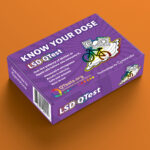LSD QTest
$24.95
Know Your Dose! The potency of LSD blotter or liquid can vary tremendously. With this LSD test kit, you can quickly and easily determine how many micrograms of LSD are in each square of blotter you have, or in each drop of liquid.
• Results in 12 minutes.
• Works with liquid, blotter and sugar cubes.
• Easy evaluation with the enclosed color chart.
• The only quantitative LSD test kit on the market.
Automatic Bulk Discounts
Get 20% off when you buy five or more QTests.
- Description
- Instructions
- FAQ
Description
Know your dose with the LSD QTest
The LSD QTest is the world’s first quantitative LSD test kit on the market. It can tell you how many micrograms are in each square of your blotter or each drop of liquid . . . before you ingest it.
Use one drop of liquid or one half a hit of blotter, then compare the color of the detection vial to the enclosed color chart.
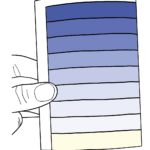
It’s that simple.
Instructions
Instructions
Note: A paper version of these instructions comes with your order.
IMPORTANT INFORMATION! – READ THIS FIRST
• Use this kit at room temperature. (If stored in a refrigerator, let it warm up for one hour first.)
• Perform the test on a flat surface during the daytime.
• Evaluate the result in daylight immediately after the 12-minute development time. (The color can change if you wait too long.)
• Use a white, letter-sized sheet of paper as a background when evaluating the color. (See section four for evaluation details.)
• Read all the instructions at least once through before beginning the test.
1. BACKGROUND INFORMATION
This test kit can be used to detect the active ingredient LSD-25 (lysergic acid diethylamide) and its concentration in blotter, liquid, and sugar cubes. It does not work on gel tabs.
The kit does not react to 1P-LSD, 1cP-LSD, ALD-52 or ETH-LAD
When testing blotter, you should only test half of a dose. The end result will tell you how many micrograms of LSD are in the entire dose.*
When testing liquid LSD, use only one drop. But remember, the end result tells you how much is in two drops.**
When testing sugar cubes, you need to crush and mix up the sugar first. Weigh out and test one quarter (1/4th) of the sugar, then multiply the end result by two.***
IMPORTANT! – Always shake your vial of liquid LSD (and empty and refill the dropper a few times) before dosing out a drop. Liquid LSD tends to settle at the bottom of the vial. If you forget to shake it first, you could end up accidentally ingesting a dose ten or even twenty times larger than expected. Similarly, the liquid in a vial of LSD can evaporate over time, increasing its concentration. (The LSD doesn’t evaporate away. Only the liquid evaporates.) This is particularly true with alcohol solutions, and it can happen even when the lid is tightly closed. Make sure and take this into account. Older vials that have been sitting around for many months can become more potent over time.
* Each perforated square in a given sheet of blotter will typically be the same dose. This is because the entire sheet was dipped into a tray of liquid LSD, and the LSD was absorbed evenly throughout the sheet. We designed the LSD QTest so that you only need to test half of a dose (half a square of blotter), and the result will tell you how much LSD is in each full dose (each full square of blotter) belonging to the same sheet. Keep in mind if you have individual squares of blotter that are not connected to each other (i.e., if the perforation was broken when you obtained them) then they may not come from the same sheet. Only connected squares can be assumed to come from the same sheet.
** When testing one drop of liquid LSD, the result tells you how much LSD is in two drops. So remember to divide the end result in half in order to determine how much LSD is in one drop.
*** When a drop of liquid LSD is individually dropped onto an absorbent medium such as a sugar cube, it does not absorb evenly. This is why you need to homogenize it before you test it (by crushing and mixing thoroughly). Also, all that sugar won’t fit into the extraction vial, so just use a quarter of it. Then multiply the end result by two to determine the amount of LSD that was originally in the entire cube.
2. PREPARING FOR THE TEST
Take out all the items from your kit. Along with these instructions, you should have:
• protective gloves
• glass vial with screw cap (the extraction vial)
• dropper vial with green lid (detection reagent)
• evaluation color chart
3. PERFORMING THE TEST
3.1 First put on the enclosed nitrile gloves and wear appropriate protective clothing and safety glasses. If you wear contact lenses, remove them. The liquids in the vials contain acids which may cause skin irritation or severe eye damage. In the event you come in contact with the liquid, remove the affected clothing immediately and rinse the affected skin area with water for several minutes. In case of eye contact, rinse the affected eye with running water for several minutes. (Keep pets, especially cats, away from the testing area.)
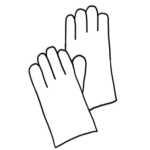
If you are testing blotter, carefully cut it in half diagonally from one corner to the other using a fine pair of scissors. If you are testing a sugar cube, put it into a small zip lock baggie. Crush it up and shake it well, then pour all of it onto a milligram scale and weigh it. Write down the total weight. Now use the same scale and weigh out one quarter (1/4th) of the total for the test.
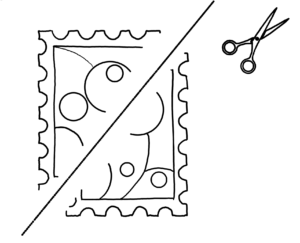
3.2 Open the glass vial and add the half piece of blotter (or the quarter amount of sugar). If you are testing liquid LSD, just add one drop. Put the lid back on the vial, close it tightly and shake it for about one or two minutes.
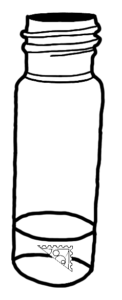
For blotter, let the vial rest for five minutes and then repeat the process two more times to make sure all the LSD is extracted. During the five-minute resting periods, make sure the blotter is suspended in the liquid, not stuck to the side of the glass, or to the underside of the lid. Shaking three times with a five minute resting period in between is enough to extract all the LSD even from the thickest blotter. (For thinner blotter, you don’t really need to repeat this process three times, but we suggest it anyway just to make sure.)
3.3 Open the extraction vial again and place it in a safe position. Remove the green cap from the plastic dropper vial and carefully empty the entire contents into the glass vial by squeezing it with even pressure. Put the lids back onto both vials and close them tightly.
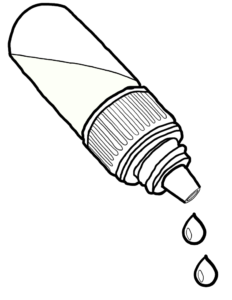
3.4 Gently invert the glass vial four or five times to mix the reagents together and then set the vial down. In the presence of LSD, the liquid will begin turning a blue color immediately.
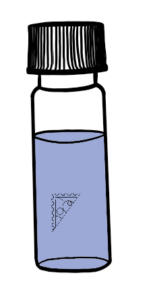
3.5 Wait 12 minutes for the color to completely develop. The result can then be read and interpreted using the enclosed color chart. See the next section, “EVALUATING THE RESULT,” for details.
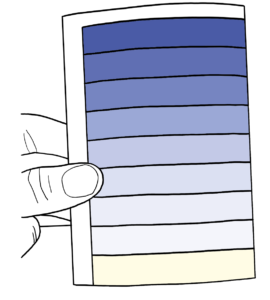
IMPORTANT! – If you see blue spots or streaks on the blotter, this indicates that not all the LSD got extracted from the blotter. In this case the result will be inaccurate. (Your LSD is actually more potent than the result indicates.) This will only happen with thicker blotter if you did not carefully follow the instructions in section 3.2 above.
4. EVALUATING THE RESULT
Follow the instructions above and wait 12 minutes before evaluating the result, but do not wait much longer than 12 minutes. Set a timer.
By comparing the intensity or saturation of the liquid in the vial with the enclosed color chart, you can determine the result visually. In the presence of LSD-25, the detection reagent turns bluish over time. Daytime sunlight is best suited for optimal evaluation. If using artificial light, the influence of different color temperatures may slightly change the hue. You can still perform the evaluation, but you should take this into account (e.g. high blue content in energy-saving lamps, green discoloration when using LED light from cell phones, etc).
SPECIFIC EVALUATION INSTRUCTIONS
• Use a white, letter-sized sheet of paper as a background.
• In daylight or under bright light, hold the glass vial next to the color chart about six to eight inches in front of the white sheet of paper and look through the glass vial head on. For best results, your eyes should be fairly close to the vial, but no closer than about six to eight inches.
• Now compare the color of the liquid in the vial to the color chart. The corresponding concentration of LSD listed on the color chart is twice the amount of LSD that you tested. So if you tested half a square of blotter, the concentration listed indicates the amount of LSD present in the entire square.
• If you tested one drop of liquid, the corresponding result indicates how much LSD is in two drops of the liquid. (So divide the result in half to calculate how much is in one drop.)
• If you tested a quarter of a sugar cube, the result tells you how much LSD is in half the sugar cube. (So multiply the result by two to calculate how much LSD was in the entire, original cube.)
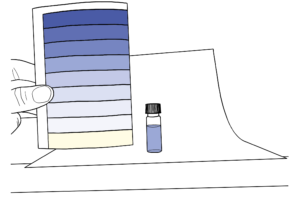
5. STORAGE AND SHELF LIFE
Store the reagents out of direct sunlight for a shelf life of at least 18 months.
6. WARNINGS
• Keep the kit away from children and animals.
• When performing the test, wear suitable protective gloves, clothing and face/eye protection. If you wear contact lenses, remove them before using the test kit.
• The liquids contained in the dropper vial consist of various acids which may cause a corrosive/irritating effect on the skin or severe eye damage/irritation. Avoid contact with the skin, eyes, mouth or clothing.
• Should contact with the above listed areas occur, remove the relevant clothing immediately. Instantly rinse the affected skin areas with water for several minutes. In case of contact with the eyes, immediately rinse them with water for several minutes using both hands to keep the upper and lower eyelids open.
• Substances processed with the test kit are not to be consumed!
• The solution in the extraction vial is flammable. It’s just a small amount, but please don’t smoke while performing the test.
7. DISCLAIMERS
• QTests are only to be used for the detection and quantification of unknown substances.
• The result may not be 100% accurate. Your sample could be adulterated with one or more unknown substances that cross-react with the reagents, affecting the quantitative result.
• The result does not mean your sample is safe to consume. It could still contain unwanted substances and impurities that can be harmful or even deadly.
• The LSD QTest is not a substitute for laboratory analysis.
• miraculix and/or Qtests.org assume no responsibility for the use or misuse of the test kit or the results.
8. DISPOSAL OF MATERIALS
Check your local regulations for proper disposal of acids.
FAQ
Coming soon.

